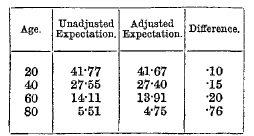No CrossRef data available.
Article contents
On the Value of Selection amongst Assured Lives, and its effect upon the Adjustment of a Scale of Premiums, as between Persons Assuring at Different Ages
Published online by Cambridge University Press: 18 August 2016
Extract
I cannot better introduce the subject of this paper than by a quotation from Mr. Morgan’s Preface to his Tables of the Experience of the Equitable Society. He writes as follows :—
“In a body of lives of the same age, all selected as healthy from the general mass of mankind, it is obvious that the rate of mortality must be considerably less for the first ten or twenty years after selection, than amongst those from whom they are thus chosen. As, however, these selected lives advance in age, their general health and the rate of mortality amongst them will naturally approximate to the common standard. This approximation cannot be accurately estimated, if the observations be taken from a blended mass of lives, selected at the age of twenty, for instance, which have attained the age of fifty, and of lives selected at the age of fifty. The rate of mortality will for the former class be less, for the latter greater, than that which occurs in either class separately.
Information
- Type
- Research Article
- Information
- Copyright
- Copyright © Institute and Faculty of Actuaries 1878
References
page 3 note * The Council have been deterred from printing the very judiciously constructed tables appended to this paper, in consideration of the expense it would involve. They trust that the omission will he less felt inasmuch as the results are all given in the following pages.
page 3 note † For example:—

page 6 note * I am aware that both these modes of addition have been employed by insurance companies, although I do not know that any have combined them.
page 11 note * P represents the “pure” annual premium, c the rate of commission, p the constant addition to the single premium, for profit, and ϵ the constant addition to the annual premium, for expenses.

